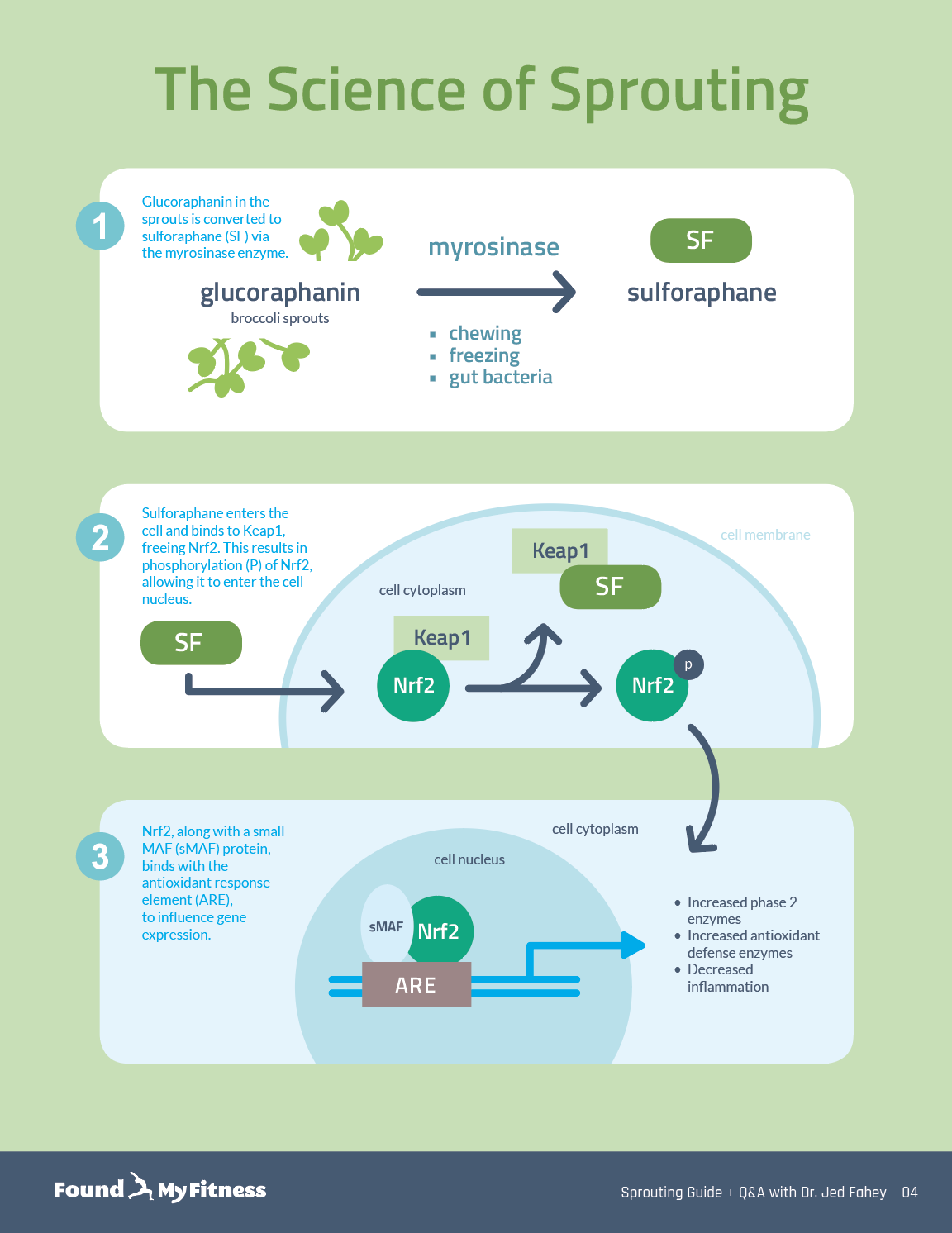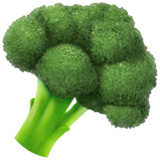What to consider when choosing probiotic supplements | Jed Fahey
Enter your email to get our 15-page guide to sprouting broccoli and learn about the science of chemoprotective compount sulforaphane.
Broccoli sprouts are concentrated sources of sulforaphane, a type of isothiocyanate. Damaging broccoli sprouts – when chewing, chopping, or freezing – triggers an enzymatic reaction in the tiny plants that produces sulforaphane.

Get the full length version of this episode as a podcast.
This episode will make a great companion for a long drive.
Probiotic bacteria are widely defined as live microorganisms that, when consumed in sufficient amounts, confer a health benefit on the consumer. The widespread usage of probiotic supplements has preceded the scientific evidence of their efficacy, however. Many probiotic supplements contain insufficient numbers of bacteria to elicit a beneficial response and many are not stored properly to maintain the viability of the bacteria they supposedly contain. In this clip, Drs. Jed Fahey and Rhonda Patrick discuss concerns about the safety and efficacy of probiotic supplements.
Jed: This whole issue of probiotics...
Rhonda: Yes. That was going to be my next question. That would be interesting to view.
Jed: Well, it's fascinating. You know, in Europe, there is a lot, I think the regulatory climate in Europe for probiotics is a bit more receptive than in the U.S. You probably know more about it than I do. But I know that the use of probiotics seems to be increasing in the U.S., and studies by those who are expert in the field of probiotics are mixed.
Rhonda: Well, it's the same case as the glucoraphanin sulforaphane supplements. A lot of the probiotics in the market, there is a lot of dead bacteria in them...
Jed: A lot of garbage, yeah.
Rhonda: ...a lot of garbage. I mean, this is ubiquitous in all supplements. You know, I think there was even a study showing something like 70% of, like, a lot of these supplements on the market are not actually what they say they are, they don't have the concentrations they say. But, yeah, I think that there is a lot of mixed data and that comes down to not having quality probiotics and also the numbers. That's another problem, too low numbers of....
Jed: Right, 10 billion per...
Rhonda: Yeah, that's nothing. You know, it's like a drop in the pool. It's not going to even move the needle. But there is a probiotic out there that I've seen at least two dozen publications including clinical trials in humans and then there's more mechanistic studies in animals using VSL #3. It's called, they're sachets and they have 450 billion probiotics per sachet and they have a mixture of lactobacillus and Bifidobacterium and some other ones but showing efficacy in treating IBS, Crohn's. You know, so I think you can find quality probiotics, but it's just, again, it's the same thing that you've seen in your field, is finding the right one.
Jed: Absolutely. I think the issue of the numbers of cells, I mean, to a non-scientist consumer, "billions" sounds like a huge number. Well, yeah, it is, but it's still...you know, you can fit a billion bacteria on a pin, probably, well, maybe a teaspoon. Anyway, the issue there, though, is a lot of the issue is survival. So if you boast about having billions of bacterial cells of a certain type in yogurt, for example, and you're not on proton pump inhibitors, so you have an acid stomach and you send that yogurt through your stomach, how many of those bacteria actually make it through the acid environment of the stomach? So, I mean, people have studied that certainly, but there are studies, as you say, with a small number of specific strains showing effects. I think some of the more striking effects have to do with childhood diarrhea and there are even studies showing effects on asthma.
Rhonda: Effects on the brain. It's incredible.
Jed: Yeah. So I'm absolutely a believer that what's goes on in the gut matters to the rest of the body. There is no question about it. I think, as you say, a lot of the studies suffer from the fact that what's being given probably couldn't have been expected to be efficacious anyway because it just died or didn't get there. But speaking of probiotics, wouldn't it be cool if someone came up with a myrosinase containing strain and put it in a probiotic formulation so that you could take that along with your cruciferous vegetables?
Rhonda: So cool.
Jed: I believe that there are companies that are working on that now because certainly, it's well enough known what strains of bacteria have myrosinase activity. There may be issues of getting that activity maintained when you grow up vats full of bacteria to freeze-dry them, to put them in a formulation. But I hope it's only a matter of time before we see formulations that contain myrosinase and that are safe. I mean, obviously, safety of these probiotic formulations is something that is a concern to the regulators and it should be. So we'll see. I don't think we're quite there, but I hope we are getting there.
A genus of bacteria known to inhabit the human gut. Bifidobacteria are anaerobic commensal bacteria. They are among the first bacteria to colonize the infant gut and may play critical roles in gut-mediated immune function.
An inflammatory bowel disease that causes inflammation of the lining of the digestive tract, which can lead to abdominal pain, diarrhea, fatigue, weight loss and malnutrition.
A class of edible plants from the Brassicaceae, Capparaceae, and Caricaceae families, so named for their cross-shaped flowers. Crucifers contain glucosinolates and myrosinase, which react to form isothiocyanates, a class of compounds with known beneficial health effects in humans. Cruciferous vegetables include arugula, broccoli, bok choy, Brussels sprouts, cabbage, capers, cauliflower, cress, collards, kale, kohlrabi, moringa, mustard, papaya, radish, rutabaga, turnips, wasabi, and watercress.
A glucosinolate (see definition) found in certain cruciferous vegetables, including broccoli, Brussels sprouts, and mustard. Glucoraphanin is hydrolyzed by the enzyme myrosinase to produce sulforaphane, an isothiocyanate compound that has many beneficial health effects in humans.
A group of symptoms—including abdominal pain and changes in the pattern of bowel movements without any evidence of underlying damage. It has been classified into four main types depending on if diarrhea is common, constipation is common, both are common, or neither occurs very often. The causes of IBS are not clear.
A family of enzymes whose sole known substrates are glucosinolates. Myrosinase is located in specialized cells within the leaves, stems, and flowers of cruciferous plants. When the plant is damaged by insects or eaten by humans, the myrosinase is released and subsequently hydrolyzes nearby glucosinolate compounds to form isothiocyanates (see definition), which demonstrate many beneficial health effects in humans. Microbes in the human gut also produce myrosinase and can convert non-hydrolyzed glucosinolates to isothiocyanates.
An isothiocyanate compound derived from cruciferous vegetables such as broccoli, cauliflower, and mustard. Sulforaphane is produced when the plant is damaged when attacked by insects or eaten by humans. It activates cytoprotective mechanisms within cells in a hormetic-type response. Sulforaphane has demonstrated beneficial effects against several chronic health conditions, including autism, cancer, cardiovascular disease, diabetes, and others.
Supporting our work
If you enjoy the fruits of
 , you can participate in helping us to keep improving it. Creating a premium subscription does just that! Plus, we throw in occasional member perks and, more importantly, churn out the best possible content without concerning ourselves with the wishes of any dark overlords.
, you can participate in helping us to keep improving it. Creating a premium subscription does just that! Plus, we throw in occasional member perks and, more importantly, churn out the best possible content without concerning ourselves with the wishes of any dark overlords.
Sulforaphane News
- Sulforaphane extends lifespan and healthspan in worms via insulin and insulin-like growth factor-1 signaling.
- Paul Saladino, MD explains how we may have overstated the health benefits of plants and especially sulforaphane
- NRF2 much of a good thing (December 2017)
- A pilot trial finds sulforaphane treatment increased glutathione levels in the blood & hippocampus region of the brain in healthy people.
- A new study found sulforaphane (found in broccoli sprouts) improved behavior & social responsiveness in children with autism.





































































